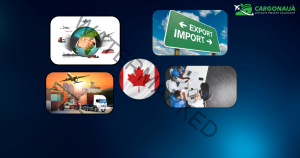Packaging is the single biggest factor in whether your shipment arrives in Canada safely and on time. This guide covers the exact materials, step‑by‑step packing methods for fragile and non‑fragile goods, the volumetric weight formula (with example), labelling best practices, and the most common errors to avoid. Airport‑to‑airport only.

Why Packaging Matters for UK → Canada Air Cargo
Good packaging protects your goods, prevents delays at airline security, and reduces handling damage at Canadian arrival warehouses. Because Cargonaija operates airport‑to‑airport for Canada, your boxes will be handled by several teams (airline, ground handlers, destination warehouse). Strong, well‑sealed cartons with clear labels are essential. For rates and booking, see our cargo from UK to Canada page.
Quick Checklist (Save This)
Double‑walled export‑grade cartons or wooden crates where needed
Cushioning: bubble wrap, foam, kraft paper, air pillows
Void fill to stop movement inside the box
Heavy‑duty tape (at least 48mm), H‑taping on all seams
Pallet straps or shrink wrap for multi‑box consignments
Printed labels on two adjacent sides + top
Contents list with values (packing list)
Photo of packed boxes (for records and insurance)
No restricted items (see list below)
Materials You’ll Need
Cartons: Double‑walled corrugated boxes (BC flute) for most items; wooden crates for heavy/fragile gear.
Internal protection: Bubble wrap, foam corners, corrugated inserts, kraft paper.
Sealing: Heavy‑duty parcel tape; avoid cloth/duct tape for main seams.
Reinforcement: Edge protectors, pallet straps, shrink wrap (if palletising).
Labels: Laser‑printed labels + clear document pouch for paperwork.
Tip: Heavier than 25 kg per box? Use multiple smaller boxes to protect handlers and reduce crush risk.
Step‑by‑Step: Pack by Item Type
1) Clothing & Soft Goods
Fold and place in clear polybags to prevent moisture.
Line the carton base with kraft paper.
Fill uniformly; keep the top layer flat so the box stacks cleanly.
Add void fill so nothing shifts when shaken.
2) Books & Documents
Use small, sturdy boxes to control weight.
Stack horizontally with cardboard dividers.
Edge protectors prevent corner crush.
3) Kitchenware & General Household
Wrap each item individually (bubble + paper).
Heaviest items at the bottom; fragile at the top.
Use dividers for plates/glassware; fill voids completely.
4) Electronics (Without Batteries)
Original manufacturer packaging is best; otherwise double‑box.
Anti‑static bags for components; foam corners for TVs/monitors.
No lithium batteries in checked air cargo—ask us before shipping power banks, laptops, etc.
5) Liquids & Cosmetics
Do not ship aerosols, perfumes, or flammables. These are typically restricted in air cargo.
Non‑dangerous liquids are generally discouraged; if essential, discuss with us first.
Seal, Reinforce, and Label (The Right Way)
H‑Tape Method: One strip along the centre seam + one on each edge (top and bottom).
Reinforce corners and high‑stress areas with extra tape.
Labels: Place on the top + one large side; avoid seams/edges.
Remove old barcodes or labels from reused cartons.
Fragile arrows help, but internal protection matters more than stickers.
Label Template (copy/paste):
Volumetric (Dimensional) Weight – with Example
Airlines charge the greater of actual weight vs. volumetric weight.
Formula (kg): (Length × Width × Height in cm) ÷ 5000
Example: A box is 60 × 40 × 40 cm and weighs 19.2 kg.
Volumetric = (60×40×40) ÷ 5000 = 19.2 kg.
Chargeable weight = 19.2 kg (because 19.2 > 16).
Measure after you’ve packed and sealed the carton. Round up to the nearest 0.5–1 kg.
Ready to ship? Get a quote…
Common Mistakes to Avoid
Overpacking one huge box instead of splitting into manageable cartons.
Gaps inside the box—movement = damage.
Weak single‑wall supermarket boxes for heavy items.
Taping only the top flap; forgetting the bottom seam.
Reusing a box with old barcodes or torn panels.
Adding restricted items (below), causing delays or rejection.
Restricted & Sensitive Items (Air Cargo)
Aerosols, perfumes, flammable liquids
Lithium batteries/power banks (unless shipped under specific rules—ask first)
Compressed gases, corrosives, hazardous chemicals
Perishables (fresh meat/dairy) and some food items
Counterfeit/illegal goods
If unsure, call 02039045521 before you pack.
Documentation You Should Prepare
Packing list: itemised contents + values
Photo ID of shipper
Any licences for controlled goods (if applicable)
Insurance declaration (optional but recommended)
We’ll issue your Air Waybill (AWB) once booked.
Before You Book (Pre‑Flight Checks)
Weigh and measure each carton; record L × W × H (cm).
Photograph each sealed box (all sides).
Keep receipts/invoices for high‑value items.
Decide whether to insure your shipment (recommended).
Confirm your arrival airport in Canada for collection.
Next step: Book UK → Canada Air Cargo
Call to Book
📞 UK Team: 02039045521
📧 Email: info@cargonaija.com
📍 Airport‑to‑Airport service only (collection at Canadian airport).
Canada Office (for arrivals & enquiries):
Cargonaija Canada, 120 1122 40th Ave NE, Calgary, AB, T2E 5TB.
Tel: 825-982-0328 | Mobile: 368-997-6199
FAQ
Q1: What’s the best box size?
A: Medium cartons (up to ~60 cm on the longest side) balance strength and stackability.
Q2: Can I send a TV?
A: Yes, if professionally crated or double‑boxed with foam corners. No internal batteries.
Q3: Do you accept suitcases?
A: Yes, but place each suitcase inside a cardboard carton for protection and labelling.
Q4: Will “Fragile” stickers protect my goods?
A: They help, but internal protection is what truly prevents damage.
















